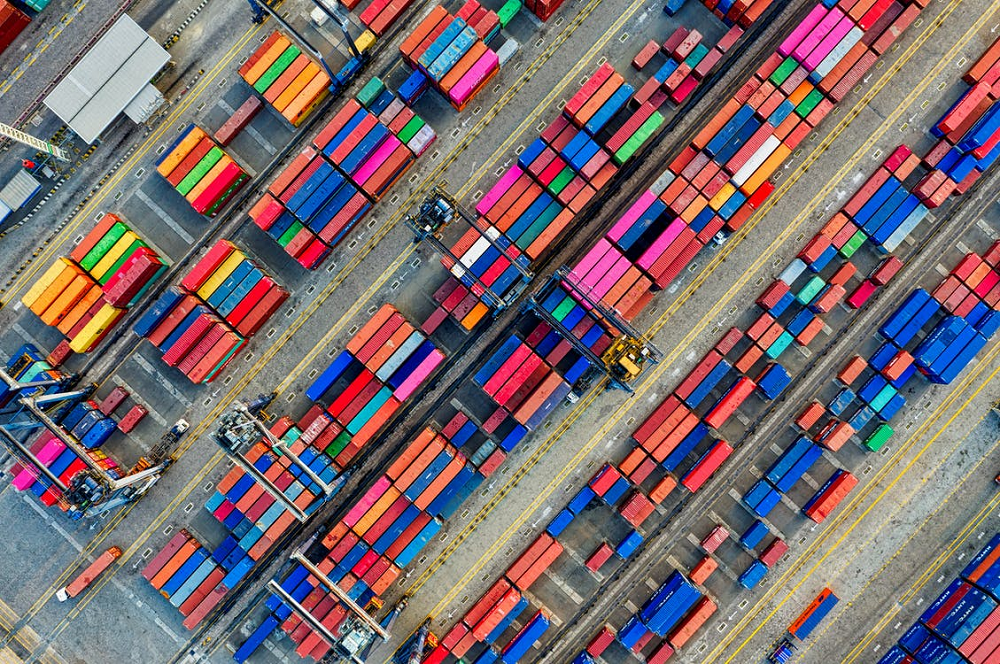
by Sam Franklin | June 16, 2022 | 11 min read
Understanding the Free Carrier (FCA) Incoterm
Get fundedLast updated: July 08, 2022
As shipping is the final step in an international transaction, it is often overlooked until the final stage. At that moment, choosing the right shipping policy might be tricky, especially if the buyer is waiting for the agreement to be signed off.
With many different shipping policies available to a seller, it can become difficult to figure out who is liable and responsible at different stages of the journey.
This is why the International Chamber of Commerce (ICC) came together in 1933 to formalise all shipping policies into eleven separate Incoterms.
If you are looking for a flexible shipping policy that allows you to control the separate moving pieces along the journey, then Free Carrier (FCA) might be the right Incoterm for you.
If you’re searching for information on the other Incoterms, take a look at our Incoterms Overview section.
Table of contents
- What is the Free Carrier (FCA) Incoterm?
- Understanding the Free Carrier (FCA) Incoterm
- When to use FCA
- When not to use FCA
- Advantages of FCA
- Disadvantages of FCA
- FCA vs other Incoterms
- Conclusion
What is the Free Carrier (FCA) Incoterm?
FCA is one of the eleven Incoterms created by the International Chamber of Commerce (ICC) in 1936. It stands for “Free Carrier”, and it dictates that the seller of the goods is responsible for delivering said goods to a destination that the buyer requests.
In international trade, the term “Free” means the seller has an obligation to deliver the goods to a named place to be transferred to the carrier, which the buyer arranges.
Interestingly, the destination for the seller to deliver the goods is known as a “Named Place”, which can be an airport, a shipping terminal, a container terminal, the seller’s warehouse, or any location in the seller’s country specified by the buyer.
Additionally, the Named Place can also be the seller’s premises. In this case, the buyer would arrange a carrier to pick up the goods. However, the seller would still be responsible for loading the goods onto the carrier at their warehouse.
The carrier will issue a bill of lading with an onboard notation as soon as the goods have been loaded onto the carriage vehicle, either in the warehouse or at a terminal port. The responsibilities are transferred from the seller to the buyer at that point. The bill of lading allows the seller to communicate with any financial intermediaries that might need proof or a letter of credit.
While the buyer is responsible for import clearance, the seller is still responsible for export clearance and taxes. Typically, the seller will factor in any transportation costs to deliver the goods to the named place in the price and assumes the risk of loss or damage until the carrier receives the goods.
Understanding the Free Carrier (FCA) Incoterm

Under the Free Carrier (FCA) Incoterm, the buyer assumes most responsibility as they have to arrange the freight transport and handle the shipping process to deliver the goods from the named place to the final destination. They must also arrange for the necessary import clearance and formalities once the goods arrive in the destination country.
As the buyer must arrange for the transport of the goods, it is one of the most favourable shipping terms because the buyer has more control of all the costs associated with the shipping. These include charges at the origin terminal and throughout the international transportation process. As a result, they can shop for the best offer available or use a freight forwarder with whom they already have an established relationship.
Unlike other Incoterms such as CIF and FOB, the FCA Incoterm is not restrictive, and buyers can use it on any transport mode such as train, boat, truck, or aeroplane.
Typically, there are usually three parties involved in every FCA transaction - the buyer, the seller, and the buyer’s carriage company or freight forwarder.
The liability for the goods transfers from seller to buyer when the goods are delivered to the carrier at the named place. Suppose the seller is responsible for arranging transport to the carrier at a location that is not a seaport or an airport, such as the forwarder’s warehouse. In that case, they are still responsible for loading the goods onto the carrier.
Once the goods are delivered to the carrier nominated by the buyer, the seller will receive a bill of lading to state that the goods have been delivered to the carrier, as dictated by the terms of sales. The seller is then free to tender the documents to the relevant bank to cash the credit.
What do FCA shipping terms include?

The shipping policy for FCA clearly outlines where the risk of liability is transferred from the seller to the buyer. Typically, it is the moment the seller hands the goods over to the freight forwarder or carrier nominated by the buyer.
It also outlines the seller’s obligations in delivering the goods to the carrier at the named place specified by the buyer. Additionally, the seller must arrange for all the relevant export formalities.
Following is a list of the standard terms seen in an FCA agreement:
The named destination for the seller to deliver the goods to the carrier.
The mode of transport used to carry the goods to the final destination.
The seller pays for transportation to the named destination.
The seller arranges all export clearance and licences.
The buyer unloads the goods at the named destination.
The buyer arranges for transportation from the designated destination to the final destination.
The buyer pays for any main carriage to the place of delivery.
Insurance is not an obligation under the FCA Incoterm rules. Therefore, it is in the buyer’s interest to decide if they would take it out themselves.
Seller’s responsibilities
In the FCA Incoterm, a seller is responsible for:
Delivering goods safely at the agreed-upon date and point
Creating a sales contract and a commercial invoice
Export packaging
Loading charges to the export location
Delivery to named port or place
Proof of delivery to the carrier
Providing notice to the buyer that goods have been delivered
Export formalities such as duty, taxes, and customs clearance
Buyer’s responsibilities
In FCA, a buyer is responsible for:
Paying for the goods as dictated in the contract of sale
Origin terminal charges
Pre-shipment inspection costs
Arranging carriage
Loading on carriage
Instructing the carrier to issue a bill of lading to the buyer
Freight costs
Destination port terminal charges
Delivery to the final destination
Unloading at destination
Assisting the seller with export clearance
Import duty and taxes
Import clearance at the destination terminal
As mentioned, it is the buyer’s responsibility to determine if insurance is required for the shipment.
Where are the risk transfers in the FCA Incoterm?

It is important to clearly understand when the risk transfers from the seller to the buyer to understand who is liable if something goes wrong.
Under FCA, the transfer of risk occurs when the seller delivers goods to the carrier nominated by the buyer at the named place - whether it be a port, the forwarder’s warehouse, or the seller’s premises.
At that point, the title transfers to the buyer, and the goods become an asset on the buyer’s balance sheet.
When to use FCA
FCA should also only be used when buyers are absolutely confident that their shipping service provider can beat the transport costs that the seller provides. Typically, buyers that use FCA already have strong relationships with freight forwarders, so they can be confident that goods will be delivered on time.
FCA is used mainly in containerised cargo shipments as the carrier is required to issue a bill of lading. Therefore, FCA should be used if the cargo is transported directly to the terminal for export.
When not to use FCA
FCA should not be used by new buyers with little experience in the shipping process. FCA requires the buyer to arrange a shipping line or freight forwarder to collect the goods from a named place specified by the buyer.
The goods must be loaded at the named place, and the buyer must provide transport documents to the seller after loading. Typically, all the steps involved become quite cumbersome for a new buyer. Therefore, other Incoterms that place more responsibility on the seller, such as DDP or CIF, might be more suitable.
Advantages of FCA
One of the main advantages of FCA is that the buyer has ultimate control over the international transportation of their goods. In addition, it allows them to adjust all of the moving pieces in the logistics chain if anything goes wrong on the journey.
If the buyer has a strong relationship already developed with a freight forwarder they can rely on, then FCA is one of the most advantageous Incoterms to choose. Strong relationships with freight forwarders will ensure that the provider finds the best price and shipping method to deliver the cargo from the origin to the final destination by the stated date.
One of the main advantages to the seller is that FCA minimises the amount of effort required on their part. All they have to do is deliver the goods to the named destination and, in some cases, only load the goods onto the carrier at their own warehouse.
Disadvantages of FCA
Although FCA is one of the popular Incoterms, there are some disadvantages to using it. For example, FCA is not particularly optimised for ocean freight as it requires additional steps at the port of origin for the buyer. These include all terminal charges and loading costs, and if there are any problems during this leg of the journey, it can lead to costly delays.
For the seller, FCA still leaves them responsible for the regular export formalities such as customs clearance and obtaining the proper licence. Additionally, the seller might not be familiar with the freight forwarder being used as the buyer arranges it.
FCA vs other Incoterms

Here is a quick comparison and summary of FCA against other popular Incoterms.
FCA vs FOB
It is recommended to use FCA instead of Free On Board (FOB) for all containerised cargo if the named place is somewhere that is not a specific terminal port (i.e. the forwarder’s warehouse or the seller’s premises).
Under FOB, the seller must deliver the goods on board the ocean vessel. However, most containerised cargo is dropped off at a container terminal before being sorted for loading. During the terminal days, the containerised cargo may be damaged, and it’s impossible to tell when the damage occurred as the containers are sealed.
Under the new FCA Incoterms 2020, the carrier issues a bill of lading, so the liability is assigned to the buyer after loading if there is any damage.
FCA vs DDP
In Delivered Duty Paid (DDP), the seller is responsible for the shipping all the way to the destination. Unfortunately, this leaves little option for the buyer to control the shipping costs and often is forced to pay higher prices.
In DDP, the risk transfer occurs when the goods are made available to the buyer as they reach the named destination.
FCA vs CIF
In Cost, Insurance, and Freight (CIF), the buyer is responsible for all transport costs until the goods reach the destination port. The seller is also obligated to buy insurance in CIF, and it must cover at least 110% of the value of the goods. However, this can only be used for sea and inland waterway transportation, so it is not always suitable for all sales.
FCA vs Ex Works
FCA is considered an excellent alternative to Ex Works (EXW) under certain circumstances. For example, in Ex Works, the carrier is not responsible for loading the goods at the place of origin. Although most carriers would take the initiative and conduct the loading, it is not an obligation under the Ex Works Incoterm.
Arranging loading can be rather tricky for the buyer in a foreign country. So instead, FCA would be a better Incoterm to use as the seller is obligated to load the goods onto the carriage.
Conclusion
The FCA Incoterm is a popular shipping policy for buyers that have experience in dealing with international trade. The Incoterm allows the buyer to arrange the best shipping options, which usually results in cheaper costs and faster deliveries.
As the Incoterm places most of the obligations on the buyer, they have to be entirely sure that they can handle arranging the logistics from the named place and trusting the freight forwarder to deliver the goods to the final destination. Therefore, FCA is not recommended for new buyers with little experience.
FCA is one of the most popular Incoterms used when containerised ships are being utilised in the shipping process as the bill of lading must be issued to the seller by the carrier. Sellers particularly enjoy using FCA because it makes shipping the goods relatively straightforward and reduces their responsibility as soon as they have delivered the goods to the carrier.
Written by

Sam founded his first startup back in 2010 and has since been building startups in the Content Marketing, SEO, eCommerce and SaaS verticals. Sam is a generalist with deep knowledge of lead generation and scaling acquisition and sales.


